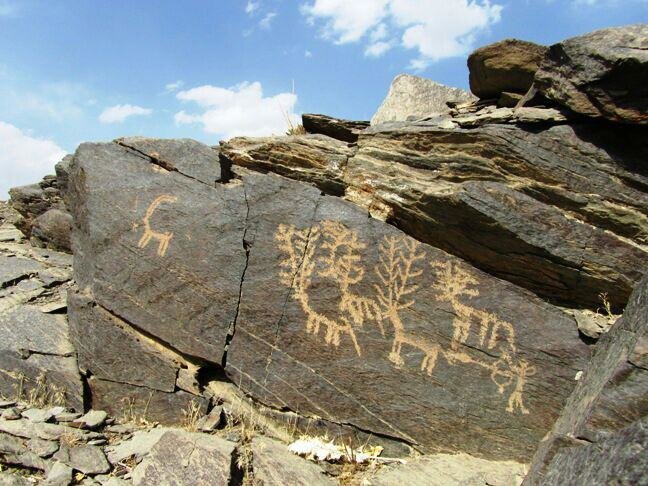Yan Cheshmeh petroglyph site made national cultural heritage

TEHRAN - The ancient petroglyph site of Yan Cheshmeh, part of the historically significant Teymareh region, has been officially registered on Iran’s national list of cultural heritage.
Yan Cheshmeh, located in the mountainous Gharaqab area of Golpayegan county, spans over 16 hectares and is renowned for its vast collection of ancient rock carvings.
According to Mostafa Ghanouni, head of Golpayegan’s Cultural Heritage, Tourism, and Handicrafts Department, Yan Cheshmeh is one of the most significant rock art sites in the Teymareh region, which itself is celebrated for its extensive collection of petroglyphs that date back thousands of years.
The registration process for Yan Cheshmeh began in 2018, thanks to the efforts of the Teymareh Cultural Heritage Association, local activists, and researchers, the official said.
“After completing the necessary documentation and legal procedures, the site was successfully added to the national heritage list under registration number 34088.”
The Teymareh region, situated at the convergence of the Markazi, Isfahan, and Lorestan provinces along the Anarbar River, covers a stretch of approximately 300 kilometers and is home to an array of ancient rock carvings and historical sites. In recent years, other significant sites within this region have also been registered as national heritage sites, highlighting the area's rich historical and cultural significance.
Ghanouni emphasized that Yan Cheshmeh stands out within the Teymareh region due to the sheer abundance and variety of its petroglyphs, making it one of the richest rock art sites in the area.
Golpayegan county, located in the northwestern part of Isfahan Province, is home to 30 registered historical sites, reflecting its long-standing cultural heritage and historical importance.
Teymareh is home to an extraordinary collection of approximately 21,000 ancient rock carvings, some of which are estimated to be as old as 40,000 years. These invaluable artifacts, however, remain unprotected and neglected, raising concerns about their preservation.
Petroglyphs are among the oldest historical and artistic remnants of humanity. Tens of thousands of years ago, long before the development of specific languages or written scripts, humans used these carvings to communicate and record their presence and living conditions.
Today, Teymareh stands as one of the largest repositories of such prehistoric art. Yet, despite its significance, it receives minimal attention from authorities and lacks adequate protective measures. According to a recent report by ILNA, the neglect is so severe that no national initiative has been established to safeguard this cultural heritage, leaving these ancient artifacts vulnerable and unguarded.
Rasoul Majidi, director of the Teymareh Friends Association and a leading researcher and guide on the Teymareh petroglyphs, shared insights into the current condition of this vast archaeological site. "Teymareh was completely unknown until a few decades ago," Majidi explained. It wasn’t until the early 1990s, when Dr. Morteza Farhadi introduced Teymareh to Iranians and the world through his book, Museums in the Wind, that the site gained any recognition.
Following the publication of Farhadi’s book, more scholars began to write about Teymareh, gradually bringing its petroglyphs to light. However, Teymareh still hasn’t received the recognition it truly deserves.
In 2005, four Italian tourists and researchers, inspired by Farhadi’s work, visited the area. Unaware of where to find the petroglyphs, they were guided by Majidi, who revealed the extensive rock carvings to them. The visitors were astounded by the sheer number of petroglyphs and, upon their return, urged for the site's preservation, emphasizing the priceless value of these artifacts.
The petroglyphs of Teymareh range from abstract to realistic depictions, encompassing a wide array of subjects, including animals, plants, and human activities. Animal figures are predominant, particularly goats with large, pointed horns. Other animals depicted include feliforms, canids, horses, dromedaries, owls, fish, tigers, cows, and birds such as storks, hoopoes, and partridges. Plant figures include cedar, pine, and wheat. Additionally, there are images of martial arts, ritual dances, pregnant women, camel caravans, and people with large hands.
Despite the historical and cultural significance of these carvings, Teymareh continues to languish without proper recognition or protection. The ongoing neglect of this site underscores the urgent need for action to preserve these ancient artworks for future generations.
AM
Leave a Comment